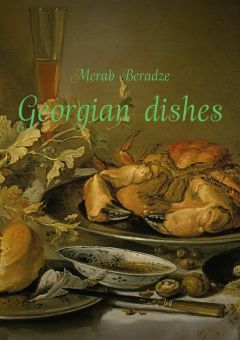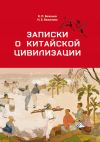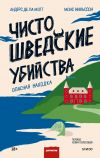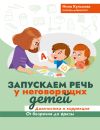Текст книги "Georgian dishes"

Автор книги: Merab Beradze
Жанр: Кулинария, Дом и Семья
Возрастные ограничения: +12
сообщить о неприемлемом содержимом
Текущая страница: 2 (всего у книги 2 страниц)
Aubergines with Walnuts

Products:
12 kg aubergines
1.5—2 glasses walnuts
3—4 cloves garlic
Parsley, celery, estragon, coriander – 3 sprigs each
Vinegar, pepper, salt to taste
Cut off aubergine heads and make a deep cut on their body. Put the aubergines into a saucepan and stew in their own juice. When the aubergines are ready, put them on a dish and press down with something heavy to let all the juice out. Mix pounded walnuts, pounded garlic and greens and stuff the aubergines with the mass. Put the aubergines on a plate and pour over some walnut oil.
Enjoy with “Saferavi” or “Tsinandali” wine.
Boiled Eggs with Estragon

Products:
10 eggs
100 g butter
2 big bunches young estragon
Green onions, dill, parsley (1 bunch each)
Salt and black pepper to taste
Shell and shred 10 boiled eggs. Shred 2 bunches of young estragon, green onions, coriander, dill and parsley. Add the shredded greens to the eggs and stew in butter. Add salt and black pepper to taste.
Enjoy with “Saferavi” or “Tsinandali” wine.
Kharsho (Soup) with Walnuts without Meat

Products:
200—250 g green onions
50—60 g butter
1 glass walnuts
2—3 sprigs coriander
0.5 kg tomatoes
0.5 glass of rice or vermicelli
Salt, pepper, garlic, greens to taste
Stew finely shredded green onions in butter. Pound walnuts, coriander, garlic, pepper and salt, and thoroughly mix them together. Add 1 litre of cold water, pour over the stewed onions, and let them boil. Add rice or vermicelli. Mince red tomatoes, boil them unitl thick, and add into the soup. While kharcho is boiling, add in finely shredded parsley and coriander. Approx. 20 min after putting kharsho off the stove, add in 30 g of butter.
Enjoy with “Saferavi” or “Rqatsiteli” wine.
Red Lobio (Beans) with Walnuts

Products:
1 kg beans
2 bulbs onions
1.5—2 tea-glasses walnuts
1/2 tea-glass vinegar
2 teaspoons dry suneli
2 teaspoons coriander seeds
4 sprigs parsley
Salt, garlic and pepper to taste
Cook red beans well and pour off the juice. Mix pounded walnuts, dry suneli, garlic, coriander seeds, parsley and salt, add vinegar and pour this mixture into the beans. Strew with sliced onions, coriander and parsley.
Lobio is well served with tchadi and ghomi.
Enjoy with “Saferavi” or “Tsinandali” wine.
To better enjoy the taste of food made from Lobio (Beans) we would recommend you to have it with pickles (the recipes of which are given in the end of the book).
Tomatoes with Walnuts

Products:
1/2 kg tomatoes
3/4 glass dry walnuts
1—2 cloves garlic
Greens, 3—4 sprigs each
Wash tomatoes in cold water, cut into approx. 8 equal pieces each and strew with pound dry walnuts, garlic, pepper, dry saffron (“yellow flower”). Dilute some salt in vinegar. Add shredded green onions, parsley, coriander, and dill. Pour the seasoning over the chopped tomatoes and stir carefully not to damage the tomato pieces. Before serving, strew the tomatoes with shredded dill.
Ghomi

Warm up some water. Pour in corn flour to get a thick mass. When the mass boils up, pour in some more flour and stir thoroughly. Cook on a small fire. Do not add flour any more, otherwise the ghomi will be spoiled. As well as tchadi, ghomi is served while hot, better with thin slices of soft cheese or sulguni put into the ghomi.
Tchadi

Pour some warm water into sieved corn flour and mix. Spread the paste on a frying pan, close the cover and bake. Serve while hot!
Shila Pilaf

Products:
1 kg mutton
1000 g fat tail
2—2.5 glasses rice
2—3 bulbs onions
1 teaspoon caraway
Salt and black pepper to taste
Wash fat mutton and cut it into small pieces. Put pieces of fat tail into a saucepan and stew until it starts to melt. Add in finely shredded onions and pieces of meat, and continue to stew avoiding frying meat or onions – otherwise the pilaf will not be white. Pour in some water. When the pilaf boils, remove the scum and add laurel leaves and salt. When the pilaf is half-ready, add rice, and continue cooking. Add black pepper and caraway to taste.
If the pilaf is too thick, add some broth or water.
Enjoy with “Saferavi” or “Tsinandali” wine.
Tomato Sauce (Megrelian Recipe)

Products:
1 kg red dry peppers
300 g garlic
5 kg tomatoes
1 bunch coriander
2 tablespoons adjika
2 spoons utskho suneli
1 spoon sunflower oil
The Megrelian sauce is made with tomatoes with Megrelian adjika. To make the adjika, take red dry peppers and mince them with coriander, utskho suneli, and garlic.
Smash tomatoes, boil them, put off the stove, and squeeze. Add the adjika to the tomato juice, pour the juice into bottles, cover with oil, close tightly and keep in a cool place. In winter the tomato sauce will be irreplaceable for the Georgian table.
Sauces (Satsebela)

Sauces enrich the food and accentuates its taste. In addition, sauces include vitamins, active bio admixtures, antioxidants (antineoplastic), etc, and help in processing and assimilating the food.
Churchkhela

Products:
250 g sweet grape flesh
25 g white wheat flour
40 g walnuts / nuts
50 g raisins / dried plums
Churchkhelas from the region of Kakheti are the best in Georgia! The churchkhelas can be stuffed with walnuts, nuts, raisins, and dried sweet plums. In order to prepare the churchkhela paste, take the flesh of white grapes and boil it down to 1/3 of the initial volume. Leave the juice to cool, and add white wheat flour mixed with corn flour (proportion 1:1) to get a thick paste. Squeeze the paste and boil it again for approx. 10 min., stirring carefully to prevent the flour from clotting. Bead the stuffing on strings and dip into the boiling paste twice. Hung them on a long bar and keep in a shaded place until well-dried and hardened.
Gozinaki

Products:
500 g walnuts
250 g honey
3—4 spoons sugar
Slice white and healthy walnuts and fry until browned. Leave the walnuts to cool, then put them on a dish and shake thoroughly to remove the peels.
Pour 250 g of honey on a deep thick-bottomed pan and boil until foaming. Put the pan off the stove for several minutes, and then boil again. Soon the honey starts to boil quietly. Put some drops of honey on a saucer and let them cool. If the honey rolls up between your fingers as paste, put walnuts into the honey and stir to prevent the mass from sticking to the pan bottom. Cook for approx. 10 min., then add a teaspoon of sugar powder, stir well and put the pan off the stove. Roll the mass out on a wet board or an enamelled dish and level it with a big wooden spoon.
Pelamushi (Grape Jelly)

Products:
3 litre grape juice
4 glasses corn / wheat flour
Squeeze grapes, pour the sweet juice into a saucepan and put on the stove. Boil for 10/15 min., removing the scum, then put off the stove and leave to cool. Add corn or wheat flour to get a thick jelly-like paste. Put on the stove again and continue boiling for approx. half an hour. Put the pelamushi on plates and serve only after cooling.
Walnut Jam

In the Georgian cuisine there are various jam recipes, and jam can be made of cherry, brier, peaches, white merry, rose petals, quince, dogwood, figs, lemons, oranges, blackberry, peers, melons, tkemali, water-melons, plums, grapes, blackthorn, raspberry, apples and other fruit. Georgian women even make jams of some vegetables: aubergines, green tomatoes, etc. Still, jam of walnuts is said to be a special one.
Peel unripe green walnuts, and make several small holes in the walnuts, using a fork or other sharp-pointed tool. Put the walnuts in cold water for a week, refreshing the water every morning and evening. On the seventh day take the walnuts out of the water and put into a dish; pour over 3—4 handfuls of lime, add water to cover the walnuts and leave for a day. Then take the walnuts out and wash them thoroughly to remove the smell of lime. Put 4 kg of sugar into 4—5 litres of water, put the walnuts in, and boil for 15 min. Add 0.5 spoons of vanillin, clove and cinnamon, wrapped into a piece of gauze. Boil the syrup until thick, and put the saucepan off the stove. Put the walnuts into glass jars and pour in the syrup to cover them. Cover the jars with parchment and keep in a cool place. Experience proves that if you cook the jam exactly to the recipe, it will preserve its taste and transparency for several years.
Dear Reader
As we told you at the beginning, we do not claim to give a full overview of the Georgian dishes and get you to know the basics of the Georgian cuisine. It would be impossible even in a thicker volume, as the Georgian cuisine is hundreds of years old. However, we believe the dishes we have described would suit your taste. We also trust that the meals would remind you of a small beautiful country far away, and would take you back to the people with ancient culture and traditions, sons of the soil from the very first day, who call their country “Georgia”, meaning “The Land of Husbandmen” – the land where cookery counts high together with other virtues. We would be glad to know that we have satisfied your curiosity at least to some extent and have enriched your diet.
Hopefully, you will cook our Georgian dishes for weddings, feasts and birthday parties – the dishes that are better served with ancient world-known Georgian drinks!
And Finally, Please Find Some Useful Information Below
As all living beings, humans are complex phenomena. They think, work, breathe and move; hence they need energy, so-called “fuel”, just as all cars do! Imagine you are lucky enough to have got a brand new computerized Mercedes! (May God give us all the luck!) Just as you need petrol to start the car up, human body needs energy. Food is the major source of energy for humans, and just as well as petrol, it should be of the best quality to secure that our organism generates sufficient energy by burning the food down. From food human body receives all the essentials, including proteins, fats, carbohydrates, mineral salts, water and vitamins – all of them repeatedly discussed by various authors, the discussions being still in progress. It would be impossible to expand on all the components in detail in a thin brochure. However we believe some information would be quite useful for the Reader, since all these substances are recognized as essential for the human existence.
As mentioned above, human beings need food to generate energy, i.e. to secure health and life! The richer the food is in vitamins, the healthier the body. Hence it is extremely important what type and amount of vitamins human body receives. “Vita” is a Latin word meaning “life”. If your food is neither rich in vitamins nor diversi fied, or if you eat only products with no or little vitamins, your body is weakened and suffers from “avitaminosis”.
Researchers have pointed out vitamins that are essential for the human body, naming them after the Latin alphabet: A, B, C, D, E, etc. Let us look at each in a little more detail.
Vitamin A is of vital importance for growth and maturity. It is called “the growth stimulator”. Lack of Vitamin A leads to nyctalophia (so-called “night blindness”), which can turn into complete blindness unless the organism receives sufficient Vitamin A. The major sources of Vitamin A are butter, yolk, liver, kidneys, lungs, caviar and especially codliver oil.
The major player of the Vitamin B group is Vitamin B1, participating in protein, fat, carbohydrate metabolism. This vitamin secures normal growth, stimulates gastric and secretory functions, and prevents heart malfunctions. Lack of Vitamin B1 affects blood circulation. The major sources of Vitamin B1 are barm, rye and wheat bread, meat, milk, grains, nuts, walnuts and greens.
Lack of Vitamin C causes easy tiredness, dizziness, exhaustion, sleepiness, arrhythmia, nervousness, and loss of work ability. Insufficient supply of this vitamin damages blood vessels, causes bleeding of dents. The major sources of Vitamin C are citruses, and it is particularly essential for people engaged in intellectual work.
Vitamin D prevents rachitis; hence its vital importance for children. However, this vitamin is also necessary for adults, especially residents of the North and mineworkers. The major source of Vitamin D is codliver oil. Vitamin D is also found in fresh milk, melted and ordinary butter, yolk and liver.
One never has enough time to remember and take care of adding all necessary vitamins into one’s diet. However, they are not so hard to remember – just scissor out the receipt below, stick it on your kitchen wall, and follow the instructions!
To provide for the daily demand of essential vitamins, just include the following into your diet:
Parsley 15—20 gr.
Cress 20—25 gr.
Coriander 20—25 gr.
Leeks 60—65 gr.
Tomatoes 30—40 gr.
Spinach 25—30 gr.
Nettle 25—30 gr.
Purslane 30—40 gr.
Fruit 100—150 gr.
Together with the vitamins, human body must receive proteins, fats, carbohydrates, mineral salts and water.
Proteins: Researchers recognize proteins as the major “building material” for the human body, the foundation of all cells and tissues. The proven daily demand of organic and vegetative proteins is 80—100 g. The major sources of proteins are meat, fish, milk and eggs.
Carbohydrates: Carbohydrates are recognized to be the main “fuel” for energy generation in the human body. In addition, carbohydrates assist in processing fats. Carbohydrates are found in fruit, vegetables, grains, organic carbohydrate, milk and some dairy products.
Fats: Lack of fats weakens the human body, while excessive fats cause trouble and provoke diseases.
Fats are crucial for the body – if the organism lacks food, it burns down the fats to generate energy and survive.
The best to assimilate are fats found in milk, creams, butter, sour creams, and the easiest source to find – cod-liver oil. The aged would remember that the codliver oil helped lots of people survive over the hunger periods of the past. The daily fats demand of the human body is 50—60 gr.
Minerals: calcium, phosphorus, sodium, potassium, iodine, etc – are essential for human body, especially for growing organisms. Each mineral has its own function and is actually irreplaceable.
Human bones are mostly built with calcium, magnesium, and phosphorus.
The main source of Calcium is milk and dairy products. Calcium is also found in vegetables, yolk, and caviar. The recognized demand for Calcium is 0.8 mg for adults and 0.2 mg for children.
Magnesium assists in the hardening of the bones and normal functioning of the heart. Magnesium is found in bread, cow milk, and grains.
Phosphorus serves to balance the nervous system. The major sources of Phosphorus are meat, eggs, wheat, rye and corn flour. The daily demand of Phosphorus is 2 g for adults and 1 g for children.
Ferrates are essential to produce hemoglobin. They are found in meat and yolk. Some fruit and vegetable also are the source of ferrates, namely: lettuce, spinach, beans, wheat, berries, apples, plums, pears, grapes, and strawberry.
Iodine also is a vital mineral (e.g. the lack of iodine causes goiter disease). Large amounts of iodine are found in iodized salts – but excess of salts, as well as other above substances, also causes trouble!
Human body needs certain amount of calories, which varies for people of different age and jobs. For instance, for people engaged in intellectual jobs the daily demand is 3000 calories, while for people engaged in physical work – 3500—4000 calories. Children’s demand is much smaller.
Red Wine Here is some noteworthy information on the wine. According to the statistical data, the French are 3 times less likely to get a heart attack than the Americans, although they consume approx. an equal amount of fats. The reason behind it has proved to be the red wine containing plenty of anti-oxidants, which prevent aging of cells that the French drink regularly. Some time ago, Canadian researchers discovered that those who drink moderate quantities of red wine at dinner are three times less likely to get the prostate gland cancer than those who do not. The doctors of the Russian town of Ekaterinburg recommend a glass of red wine every day to those sensitive to the climatic conditions. A group of researchers in the US state of Michigan believe that like green tea and aspirin, the red wine is good for preventing the old age deafness and, also, protects the submarine sailors and astronauts from radioactive substances. A glass of red wine a day is no less wholesome for women, too.
Правообладателям!
Это произведение, предположительно, находится в статусе 'public domain'. Если это не так и размещение материала нарушает чьи-либо права, то сообщите нам об этом.








































